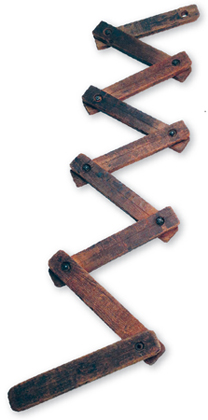
THE LADDER PICTURED was the means by which burglar Charlie Peace would climb down from the roofs of houses.
In the early hours of Thursday, 10 October 1878 the police were on special alert in Blackheath, south-east London, because of a spate of night-time household burglaries. PC Edward Robinson noticed a flickering light to the rear of a house in St John’s Park and sought assistance from his colleagues. When Sergeant Brown rang the doorbell of the house, Robinson saw a figure escape from the dining-room window and run across the back lawn. The officer gave chase and was shot at five times and wounded in the arm before the burglar was finally overpowered with assistance from PC William Girling. The man gave his name as John Ward and refused to state his address, but was duly charged with burglary and with wounding Robinson. At the Old Bailey the burglar was convicted and sentenced to penal servitude for life. It was before the introduction of a gallantry medal for these circumstances, so the grateful residents of Blackheath presented Robinson with a pocket watch. It was also before the introduction of the fingerprint system to identify criminals with records under a different name.

1878
Folding ladder for hooking on to windowsills etc.
Two weeks before the Old Bailey trial was due to begin, Ward, who was held in Newgate prison, had requested a visit from a Mr Brion. So, still uncertain about Ward’s identity, Detective Inspector Henry Phillips arranged for Brion to be followed from the prison to his address in Peckham Rye. Brion, a respectable cartographer, knew Ward as Mr Thompson, who claimed to be working on an unsinkable boat that required him to go out late at night to test his invention. With Brion’s assistance, Phillips then interviewed Susan Thompson who refused to disclose any details of John Ward, with whom she was living, notwithstanding that an apparently stolen watch had been found in her bedroom. She would not speak about Ward’s true identity, but eventually wrote down in Phillips’ pocketbook that Ward’s real name was Charles Peace of Sheffield.
Peace (46) had been living a seemingly respectable life in Peckham. He dressed well to avoid suspicion, entertained friends with his violin playing (apparently being referred to as ‘the modern Paganini’) and took part in amateur dramatics. By night, he would carry his collapsible wooden ladder to burgle houses. Other housebreaking equipment used by Peace is in the museum, along with his violin, letters and a wanted poster of the time. Peace had two fingers missing on his left hand, which would have been an easy identification feature, so he fitted himself with a tube and a hook to give the appearance that he had lost his whole hand and part of his arm.
Henry Phillips, whose unpublished recollections of the case are in the museum, travelled to Sheffield and recovered a large amount of stolen property that he traced to no fewer than thirty-six burglaries across the country. Peace was also wanted by the police in Sheffield for murdering Arthur Dyson in 1876, who had objected to Peace seeing so much of his wife, Katherine Dyson. Locally, Peace was wrongly believed to have died in a coal pit accident in Derbyshire.
Peace was escorted to Sheffield (throwing himself from a train in an escape attempt on the way), stood trial for murder and was sentenced to death in 1879. After the sentence had been passed, he also admitted to the murder of Manchester’s PC William Cock for which 18-year-old William Habron had been sentenced to death but later reprieved. Peace had even attended Habron’s trial, apparently watching him being sentenced to death for a crime that he, Peace, had committed. His confession did at least spare William Habron further imprisonment.
Susan Thompson received the £100 reward that had been advertised for Peace’s apprehension.